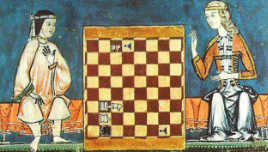Medieval games and activities
The games of medieval Europe were mainly the same as those of Egypt, Greece and Rome, like marbles and dice. Chess came to Europe from the Islamic Empire. Around AD 700, when Arabs took over Spain, they brought chess with them. Several hundred years later, playing cards also reached Europe in the 1300s. Many cities banned playing cards at first, because people used them for gambling. After a while cities allowed cards. The first European cards were hand-painted, but soon they learnt to use Chinese block-printing to make the cards cheaper. We also see more children’s toys from this time on, such as whistles and little dishes and dolls. People didn’t sit still all the time; they liked to go swimming outside in ponds and rivers too. Spectator sports were still important in medieval times. After the fall of the Roman Empire, horse racing and chariot racing continued to be popular for a long time. This was especially true in Constantinople, where the charioteers (the drivers) were divided into teams (the Blues, the Greens, the Whites and the Reds, though the Blues and the Greens were the most important). On a smaller scale, horse racing continued in Spain and Italy throughout the Early Medieval Period. You can still see a medieval horse race today at the Palio in Siena, which is held every year. Medieval European people replaced the old gladiatorial combat with the tournament, in which armed and armoured knights fought each other for prizes and for the entertainment of the king and queen and the public.

